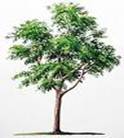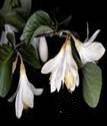| Kingdom | Plantae |
| Division | Magnoliophyta |
| Class | Magnoliopsida |
| Order | Ericales |
| Family | Styracaceae |
| Genus | Styrax |
| Species | S. benzoin |
| Binomial name | Styrax benzoin |
Other Common Names:
The other common names for the tree benzoin are Friar's balsam, Benzoin Gum, Gun Benjamin, Siam Benzoin, Sumatra Benzoin and Benzoin Tree.
History
Benzoin, also known as gum Benjamin, is one of the classic ingredients of incense. In ancient civilizations it was used in fumigation.

Description
The plant known as the benzoin gum is a shrub like deciduous tree. The plant is a member of the storax family of plants. The S. benzoin similar to many related species is a fast growing tree that can reach heights ranging from about fifteen feet to an incredible one hundred fifteen feet in some cases.


Range
Benzoin trees are also native to Thailand and Java. The tree is a native of Sumatra, Java, Borneo, and other islands in the vicinity.
Habitat
Benzoin resin (Styrax benzoin) is an evergreen tree found in the swamps and rich woodlands of Sumatra. The benzoin tree grows only in the tropical rainforests straddling much of southern Asia. It is also grown upon interior hills and sea coast plantations.
Cultivation
The method of cultivation of the plant differs from region to region and in some regions of the world, the seedlings are planted just before a crop of upland rice so that as the grain grows and advances it can give some shade to the young growing trees. Trees are cultivated in a haphazard manner. Land is roughly cleared for planting, and seeds are simply scattered on ground. Patches are abandoned for 7-10 years, until time to harvest. As a result stands of trees that were fairly thick a few years after planting are severely thinned out by competion of scrub growth. In Sumatra, benzoin is cultivated on dry rice land, in the process of reforeststion.The land must be well drained low positions are thus impractical and plantations are usually on hillsides, ususally on sandy soils. Seedlings are transplanted from nurseries to the shade of rice and then allowed to compete with weeds and second growth after the rice is harvested.
The resin is extracted from trees that are six or seven years old. Once such trees have been identified, workers slash the trees using a hatchet or make deep triangular holes into the bark using a knife, the resin is a yellowish white to reddish brown fluid which begins to flow out of these cuts and immediately hardens into teardrop shaped lumps on the bark - these are collected and used in the preparation of many herbal remedies. Benzoin trees give the greatest flow of resin during the first three years of tapping, and this flow can lasts another three years. Most benzoin trees will die before reaching seventeen years of age.
Flowering Season
The birch trees give out white silky fragrant blossoms which are in bloom throughout spring.
Pests and Diseases
It is very susceptible to bacterial canker. Another important foliage disease is target leaf spot which is caused by the fungus Cristulariella pryamidalis and is responsible for premature defoliation. Important stem diseases caused by fungi are the Fusarium cankers caused by several species of Fusarium and the perennial target canker (Nectria galligena) commonly known as Nectria canker. Cankers usually occur on the main stem where a branch broke off and left an open wound.
Parts Used
The resin or the gum is the most commonly used part of the benzoin tree for its commercial and medicinal applications.
Medicinal Applications


• Benzoin oil can be used for bronchitis, coughs, colds, wounds, acne, eczema, psoriasis, rheumatism, arthritis, scar tissue, circulation, nervous tension, stress, muscle pains, chilblains, rashes and mouth ulcers.
• Benzoin oil's greatest benefit lies in that it has a calming effect on the nervous and digestive systems, a warming effect on circulation problems and a toning effect on the respiratory tract.
• In vapour therapy Benzoin oil can be used for the nervous system, calming and bringing comfort to the depressed and emotionally exhausted.
• Benzoin oil is a good remedy for dry, cracked skin, cuts and wounds, as well as for acne and irritable and itching skin, while at the same time improving elasticity.
• Tincture of benzoin is used to treat blisters, to protect skin's surface and as an antibacterial, antiseptic and antifungal agent.
• Benzoin is a natural preservative, which makes it a great ingredient for our low-preservative cosmetic formulas.
• A tincture has been strongly recommended in anal fissure.
Commercial Applications



• Benzoin is a natural preservative, which makes it a great ingredient for our low-preservative cosmetic formulas.
• Benzoin, also known as gum Benjamin, is one of the classic ingredients of incense. In ancient civilizations it was used in fumigation.
• Benzoin is also used in the food industry as a flavouring agent, where small amounts are added to many processed foods, and these products range from different kinds of beverages to all kinds of packaged baked goods.
• Gum tincture is also used as a coating over a very well known adhesive preparation called Court Plaster.
• It is also used in the perfumery industry.

Benzoin gum has traditionally been used in India and other Asian countries. Vasco Da Gama, the Portuguese explorer was presented with a gift of benzoin, on his voyage in 1497-1498 around the Cape of Good Hope to India; the Portuguese navigator was presented this substance by the Indians who highly valued this substance. The benzoin gum has been used in incense burnt in Indian Temples for its appealing vanilla like aroma.
Styrax resin from southern Arabian species was burned during frankincense harvesting; it was said to drive away snakes. The Arabians gather frankincense by burning that storax which Phoenicians carry to Hellas; they burn this and so get the frankincense; for the spice-bearing trees are guarded by small winged snakes of varied colour, many around each tree; these are the snakes that attack Egypt. Nothing except the smoke of storax will drive them away from the trees. It is considered to be a peace and protection incense. Myths about benzoin say that it is used for purification and prosperity purposes. It is considered to be sacred to goddesses Venus and Aphridite.drive out evil, clearing, purifying and promote graet wealth.